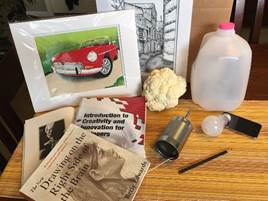|
We engineers, whether academics or practitioners, rarely use props. PowerPoint is the preferred if not automatic visual device. Heavy use of images instead of objects is ironic in that we plan, design, construct, and operate things -- products, processes, structures, facilities, and systems -- that serve societal needs and use many high tech tools. We have ready access to highly varied potential prop material, the use of which could enhance our communication effectiveness, especially for visual and kinesthetic learners.
As an aside, I wondered why we use the term “prop.” It comes from the theatrical world and is a shortened form of “property,” which means any object handled by an actor during a performance. When you and I give a presentation, we are actors giving a performance during which we strive to communicate with our audiences. Let’s use whatever works, including props.
I’ve spoken to students groups and professional societies about topics such as “Engineering Your Future in a Down Economy: 10 Tips” and “10 Tips for Success and Significance.” I use a specific set of ten props or each presentation.
After being introduced, I place a plain-looking box on a table in front of the audience while stating that I welcome the opportunity to offer 10 tips for their consideration. Then, one at a time, I pull out items like those shown here, and use each to explain a tip.

After I have offered all of the tips, the props are laying on the table in front of the audience. As part of my summary, I pick them up, one at a time, and place them back in the box. While doing that, I ask what tip each prop represents and always get many accurate answers.
As another example of prop use, I have spoken to engineering students, faculty, and others about topics such as “Using Neuroscience to Work Smarter” and “You, Your Brain, and the Rest of Your Life.” Props, like those shown here, illustrate some of my principal points. No PowerPoint used or needed.

Having done many prop-based presentations, I offer the following observations:
- The box gets the audience’s attention -- most individuals seem to welcome something instead of another PowerPoint.
- The audience stays connected because they wonder, “What will he pull out next?”
- Participants “get the message” as evidenced by the quick recall of the meaning of each prop near the end of my talk -- as I put them back in the box.
Given that vision is the dominant sense, judicious use of props will help others understand and remember your message.
Notes:
This article draws on research used to write my 2017 book Introduction to Creativity and Innovation for Engineers.
I welcome opportunities to speak, teach, conduct workshops, and collaborate about any aspect of helping engineers become even better communicators -- writing, speaking, listening, using visuals. Contact me at stu-walesh@comcast.net or 219-242-1704.
Learn More About Stu Walesh | Clients Served | Testimonials & Reviews
Managing and Leading Books | Tailored Education & Training
Home | Legal Notice | Privacy Statement | Site Map
Copyright © Stuart G. Walesh Ph.D. P.E. Dist.M.ASCE
Web Site Design, Hosting & Maintenance By Catalyst Marketing / Worryfree Websites |

